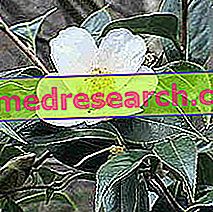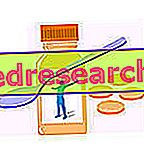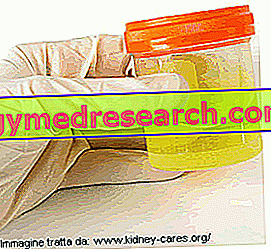
Scientific name
Camellia sinensis
Family
Theaceae
Origin
China
Used Parts
Drug consisting of fermented leaves (black tea) or unfermented (green tea)
Chemical constituents
- Xanthine alkaloids (caffeine or theine if you prefer, theobromine, theophylline);
- Vitamins (group B);
- Caffeic acid derivatives;
- Essential oil;
- Catechinic tannins;
- Flavonoids;
- Polyphenols;
- Minerals;
- Saponins.
Tea in Herbal Medicine: Properties of Tea
Green tea is known for its antioxidant, antiviral and neoplastic disease prevention properties, while black tea has interesting astringent activities and - given the greater presence of methylxanthines - it also acts as a stimulant at the level of the CNS (much less than the coffee: in fact a cup of tea contains at most 50 mg of caffeine and generally about a third of that contained in a cup of coffee).
Biological activity
Although the use of tea has not obtained official approval for any type of therapeutic application, this plant is attributed numerous properties, some of which have been confirmed by several studies.
More specifically, astringent, antidiarrheal, antibacterial, antiviral, antioxidant, preventive against tumors and stimulants for the central nervous system (CNS) are ascribed to tea.
In fact, to be more precise, the antiviral, antioxidant and tumor prevention action is mainly attributed to green tea; while the astringent and stimulating action of the CNS is mainly attributed to black tea. The latter differs from green tea in the treatment to which its leaves are subjected.
The astringent and antidiarrheal activities are due to the tannins contained in the plant, while the activity on the central nervous system is attributable to the caffeine content. In fact, this methylxanthine acts as a stimulant and also has a positive inotropic effect, as well as promoting glycolysis and lipolysis and promoting diuresis and the secretion of gastric juices.
The antimicrobial properties of tea have also been confirmed by several studies that have shown that this plant can be effective in inhibiting the growth of bacteria such as Streptococcus salivarius, Streptococcus mutans and Escherichia coli .
Moreover, some studies have shown that green tea extracts have an antibacterial action against the microorganisms responsible for the formation of dental plaque, highlighting how this plant can be a valid remedy to prevent the formation of dental caries.
Similarly, the preventive action on tumors has also been confirmed. In particular, this activity seems to be ascribed above all to the polyphenols contained in the plant. In fact, it seems that these molecules are able both to decrease the proliferation and to increase the apoptosis of malignant cells.
Several studies have been conducted on the subject, from which it emerged that the protective action of polyphenols is carried out against tumors of the stomach, intestine, colon, pancreas, lungs and breast.
The antioxidant activity attributed to tea, on the other hand, is attributable to both the polyphenols and to the catechins contained in the plant and is carried out through a mechanism of action that involves the inhibition of lipid peroxidation.
Furthermore, an in vitro study showed that green tea extracts also possess an interesting anti-inflammatory activity. This activity is carried out by the catechins contained in the plant, in particular by epigallocatechin gallate. In fact, this substance is able to inhibit the adhesion and migration of neutrophils, defense cells that play a key role in inflammatory processes.
Tea in folk medicine and homeopathy
In folk medicine, tea is used as an internal remedy for migraine, fatigue, gastrointestinal disorders, vomiting and diarrhea.
In Indian medicine, however, tea is used to treat fever, fatigue, headache and diarrhea; besides being used as a remedy to counteract the loss of appetite and excessive thirst.
In Chinese medicine, green tea is used as a remedy for digestive disorders, headaches, nausea and diarrhea associated with malaria. Furthermore, traditional Chinese medicine uses tea to prevent the onset of cancer.
Tea is also used in homeopathic medicine, where it can be found in the form of granules and oral drops.
In this context the plant is used in case of cardiovascular disorders, depressive states, states of agitation, headaches and gastric disorders.
The dose of homeopathic remedy to be taken can vary from one individual to another, also depending on the type of disorder that needs to be treated and according to the type of preparation and homeopathic dilution that you want to use.
Side effects
If properly used, tea should not cause any kind of side effects.
However, if high doses are taken, hyperacidity, gastric irritation, constipation or diarrhea, tremors, restlessness and decreased appetite may occur; while in case of overdose, nausea and abdominal spasms may also occur.
Finally, it is good to remember that taking too high doses of caffeine (or theine if you prefer) can cause agitation, irritability, restlessness, insomnia, headaches, palpitations, loss of appetite, vomiting and diarrhea.
Contraindications
Avoid taking tea or its preparations in case of hypersensitivity to one or more components, in patients with gastritis or peptic ulcer and during lactation.
The use of tea in pregnancy, on the other hand, should be limited.
Finally, patients with renal diseases, cardiovascular diseases and / or thyroid hyperfunction must use tea with great caution. Generally, in these cases, it is good to ask the advice of your doctor.
Pharmacological Interactions
- I-MAO: hypertensive crisis;
- oral contraceptives, cimetidine, verapamil, disulfiram, fluconazole and quinolonics inhibit the metabolism of caffeine, with possible increase of its stimulating effects;
- thyroid hormones, adrenaline, ergot alkaloids, ephedra, synephrine: it enhances its effects;
- oral anticoagulants: reduces their activity;
- phenylpropanolamine: increased blood pressure;
- lithium: reduction of lithium levels in the blood;
- benzodiazepines: reduction of sedative effects;
- antiarrhythmics: increased caffeine plasma concentration;
- iron: it reduces its absorption;
- Aspirin: caffeine increases its bioavailability;
- phenytoin: increases the metabolism of caffeine;
- fluoroquinolones: increase the concentration of caffeine in the blood;
- ipriflavone: possible increase in the concentration of caffeine in the blood;
- enzyme inducers: reduction of caffeine in the blood;
- macrolides: increased caffeine in the blood;
- ticlopidine: increased caffeine in the blood.



